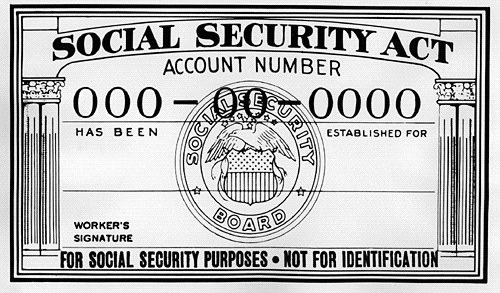One of the pieces of advice that’s floating around at the moment, with respect to retirement, is to delay collecting your Social Security benefits as long as possible.
The logic here is unassailable: even though “full retirement age” has increased to age 66 for people now hitting retirement age, and will be 67 soon (year-of-birth 1960 and later), people still think of the old Social Security normal retirement age (and still the Medicare eligibility age) as “Retirement Age,” and think of the earliest eligibility of 62 as another reasonable choice. But where one’s check was once reduced by a reasonable-looking 20%, it’s now 25%, and soon to be 30%.
What’s more, there is a substantial benefit to waiting until age 70. Compared to retiring at age 62, it’s a whopping 76% increase (77% for the NRA 67 group). Compared to retiring at age 65, it’s a 41%/43% increase. These are significant numbers.
What does this mean in terms of actual benefits? The Social Security website helpfully provides both the maximum benefits, as if a worker earned wages greater than the “wage base” for each of 35 years of employment, and an example which is based on a worker with average wages (approximately $45,000). Separately, they provide the rate at which benefits increase for each year beyond Normal Retirement Age that one delays benefits: for everyone born 1943 or later, benefits increase 8% per year after NRA up until age 70. (I assume this is simple increases, rather than compounded, because I match the figures being promoted in retirement advice, but the ssa.gov site doesn’t specify.)
This means that for the maximum-benefit-earner, annual benefits can be as high as
Retire at age 62: $24,300
NRA: $32,220
Age 70: $42,012
not reflecting adjustments for cost of living. $42,012 doesn’t look too bad, as a benefit solely from Social Security, but that’s only replacing 36% of pay, at best, for these high earners. For retirement at age 62, the rate is only 21%.
For the average earner, rates look quite a bit better. For someone with NRA = 67, we have:
Age 62: $14,088, or 31% of pay
Age 67: $20,126, or 45% of pay
Age 70: $24,956, or 56% of pay
And while $25,000 isn’t a spectacular income, it’s a heck of a lot better than $14,000.
(Note: I threw these numbers together; they haven’t been peer reviewed, or even been given much self-review.)
(What if your income is somewhere in between? That’s where the benefit formula, however admirable its goal of protecting the poor, makes it considerably more difficult for people to plan their finances.)
So certainly this argues in favor of continuing to work and deferring Social Security for as long as possible. It may even suggest being willing to spend down assets in order to defer starting benefits to a later age, if one is unemployed or otherwise not able to work all the way to age 70, or if one has sufficient assets and inclination to retire in any case, since Social Security offers two advantages that a 401(k) doesn’t: guaranteed lifetime benefits and a cost-of-living adjustment (though I admit I haven’t done the math here).
But, if one looks at the Social Security website, it’s by no means easy to find information on the significance of delayed retirement. Perhaps this is the consequence of the overall presentation of information, which is largely in the form of “calculators” and in the very simplified English (at, what, the 5th grade level?) required.
But, just for fun, let’s consider another question:
What if the benefit increases for delayed retirement didn’t stop at age 70, but the 8% per year increase was an option up as high as age 75?
Here’s the math:
Age 71: $26,600, or 59% of pay
Age 72: $28,200, or 63% of pay
Age 73: $29,800, or 66% of pay
Age 74: $31,400, or 70% of pay
Age 75: $33,000, or 73% of pay
which are percentages which start to look pretty respectable, and much closer to the expert-recommended figures for retirement income.
(Again, if your income is higher than this average, your rates will be lower — though at some point, in thinking about social policy, replacement rates aren’t as important as the overall question of whether formerly middle-income people are able to maintain a life which, while it may require cutbacks, doesn’t approach poverty or the financial struggles of those government categories of “low” or “moderate income.”)
Which raises several questions:
First of all, should the government remove the option to retire at age 62, considering how substantial the benefit reductions are?
And, second, should the government remove the cap on benefit increases for delayed retirement, and allow for increased benefits to whatever age an individual is able to delay collecting benefits? Or is this an “unfair” increase in benefit for the healthy, on the assumption that those who collect their benefits early do so for health reasons or due to unemployment, and due to no fault of their own?
Postscript:
Ultimately, this concept isn’t that dissimilar from what retirement policy-types call “longevity insurance” — the concept of which is that, at a younger age, you buy a contract for a deferred-to-75 annuity. Like car insurance, you may never need it, if you die before then. But it insures against your outliving your assets. at a more affordable price than buying an annuity that begins paying immediately upon retirement.
How does the 8% per year simple-interest increase compare with the relative cost of purchasing annuities at a given year, vs. deferring a further year? Would this hypothetical “wait until your 401(k) is exhausted to begin collecting Social Security” scenario be any different than just setting aside a pot of money to be used to buy an annuity later? This is where my knowledge of products available in the insurance market is too limited. But regardless, a “defer Social Security” strategy is more understandable and accessible to the average consumer than purchasing annuities.
















